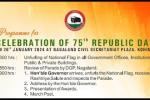

BUSHU AND JIBA - KACHARI TRIBE
The Kacharis celebrate a number of festivals in a year. Amongst them the most important ones are (a) Bushu or Buhsu Jiba which is widely celebrated by the Dimasa Kacharis and (b) Baisagn-the spring festival of the Mech (Boro) Kacharis.
The Bushu is basically a post-harvest festival and usually falls in the month of January every year after all the hard earned grains of paddy are harvested, thrashed and stored in the granaries. Although the exact date and place of the festival is not generally fixed, people see to it that it is celebrated when there is moonlight in the nights because it is believed to be auspicious. In recent years, the people have decided to celebrate the festival in the last week of January. The other festival Baisagn, is celebrated in the second week of April coinciding with the New Year's Day of the HinduCalendar. The mode of celebration of these two festivals being basically similar, the soul of these festivals is feasting and merrymaking with social-cultural activities.
Bushu is celebrated either village-wise or sometimes a number of villages in contiguous areas together organize the festival. This promotes better unity and understanding among the people of all ages and social status. The food items of the festival include rice, mutton, chicken, pork,buffalo meat and rice-beer. The killing of these animals is known as 'Meesthaiba' which involves ritualistic performance before the animals are actually killed. Thereafter, the Village Priest prays on behalf of the people and places an offering of cooked rice and meat in the name of 'Sibarai', the Creator. This offering is known as 'Meedo-Karba'. This is followed by feastingand merry making through songs and dances in which people of all ages and sex participate. Traditional sports called 'Rimin~nehlaiba'(consisting of twoopponents trying to push each other holding a wooden bar by hands below thearmpit) and 'Longthai~sugubar (lifting of heavy stones) etc. are played. Also competitions on cultural dances, folk songs, folk tales etc. are held during the festival. The dancing group also performs in honor of the village chief orany invited guest which is known as 'Bai~sengba'. The honored guest offers some'gifts' to the group as a gesture of acknowledgement of the honor.
Bushu is of three types:
1. Hangsho- which lastsfor 7 days and 7 nights.
2. Surem- lasts for 3 daysand 3 nights.
3. JidepJiba - lasts for 1day and 1 night
Among these the last one is generally observed in every village.
The origin of this festival dates back to the days of yore.From time immemorial each Dimasa village had a youth dormitory called 'Nohdrung'. All the male adults, particularly the youth lived in the dormitory and guarded the village from theft, enemy raids etc. Besides, this served as the learning center of handicraft, music, dance and other forms of art. It was from this rural institution that gave rise to the idea of holding an annual feast after the paddy grains are harvested and stored. In the later years all the villages began to give religious importance to the feast and thus it became an important festival of the people. Till today this festival is celebrated with pomp and grandeur by the Dimasa Kacharis.






